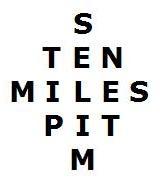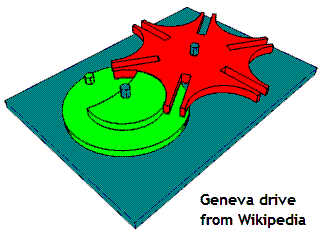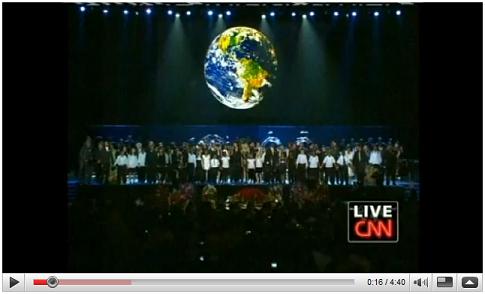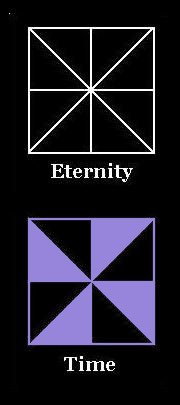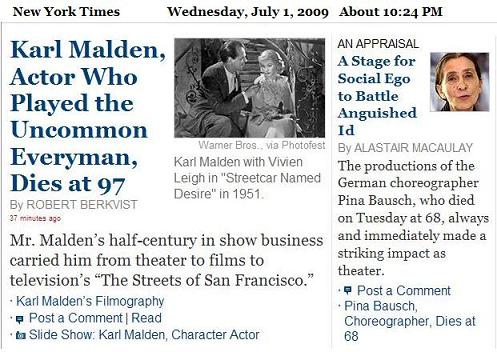Friday, July 31, 2009
Again with the…
at The New York Times.
For previous notes on
allure at the Times, see
St. Luke’s Day, 2008,
and its links.
Teaser at the top of
this afternoon’s Times’s
online front page:
“Vampires Never Die:
In our fast-paced society,
eternity has a special
allure.” (With fanged
illustration)–

Yesterday’s afternoon entry was
related to both the July 13th death
of avant-garde artist Dash Snow
and the beauty of Suzanne Vega.
A reference to Vega’s album
“Beauty & Crime” apppeared here
on the date of Snow’s death.
(See “Terrible End for an
Enfant Terrible,” NY Times,
story dated July 24.)
The Vega entry yesterday was, in
part, a reference to that context.

In view of today’s Times
teaser, the large picture of
Vega shown here yesterday
(a detail of the above cover)
seems less an image of
pure beauty than of, well,
a lure… specifically, a
vampire lure:

What healthy vampire
could resist that neck?
To me, the key words in the
Times teaser are “allure”
(discussed above) and “eternity.”
For both allure and eternity
in the same picture
(with interpretive
symbols added above)
see this journal on
January 31, 2008:
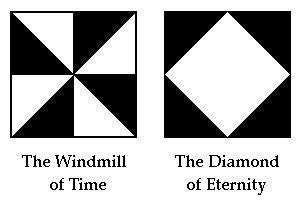

This image from “Black Narcissus”
casts Jean Simmons as Allure
and Deborah Kerr, in a pretty
contrast, as Eternity.
For different approaches to
these concepts, see Simmons
and Kerr in other films,
notably those co-starring
Burt Lancaster.
Lancaster seems to have had
a pretty good grasp of Allure
in his films with Simmons
and Kerr. For Eternity, see
“Rocket Gibraltar” and
“Field of Dreams.”
For less heterosexual approaches
to these concepts, see the
continuing culture coverage of
the Times— for instance, the
vampire essay above and the
Times‘s remarks Monday on
choreographer Merce Cunningham–
who always reminded me of
Carmen Ghia in “The Producers”–

Related material:
“Dance of the Vampires”
in “At the Still Point”
(this journal, 1/16/03).
Comments Off on Friday July 31, 2009
Thursday, July 30, 2009
The Discreet Charm
of Suzanne Vega
We keep coming back
and coming back
To the real: to the hotel
instead of the hymns….
— Wallace Stevens |


"In the room the women come and go"
— Stephen King, The Shining:
"The Wasps' Nest"
Comments Off on Thursday July 30, 2009
Academy Awards
for Cambridge
“First of all, I’d like
to thank the Academy.”
— Remark attributed to Plato

“A poem cannot exhaust reality,
but it can arrest it.“
— At War with the Word:
Literary Theory and
Liberal Education,
by R. V. Young,
Chapter One
For one such poem, see
“Life and Death United:
An Intimate Portrait of
a Man Named Miles Davis,”
from a seminar’s weblog
at DePauw University on
Sunday, November 21, 2004.
See also the four Log24
entries on that date as well
as yesterday’s entry on Davis
and the entries preceding it.
Comments Off on Thursday July 30, 2009
Wednesday, July 29, 2009
Lydian Mode
In memory of composer
George Russell, who
died at 86 on Monday —
Russell’s thoughts on the Lydian mode
strongly influenced Miles Davis,
notably in Davis’s “Kind of Blue.”
“The power of the Lydian mode,
Russell realized, is
freedom from time’s restraints.
The major scale is in a state of becoming.
The Lydian scale already is.”
— The Gravity Man, by Alice Dragoon,
quoted at LydianChromaticConcept.com
Related material:
“Field Dance,” from the date of Russell’s death.
“The Tables of Time,” from Nov. 13, 2003,
and the four entries that preceded it.
Today’s previous entry and
The Reversible Diamond Puzzle
(from St. Nicholas, November 1874)–
Comments Off on Wednesday July 29, 2009
Kaleideion
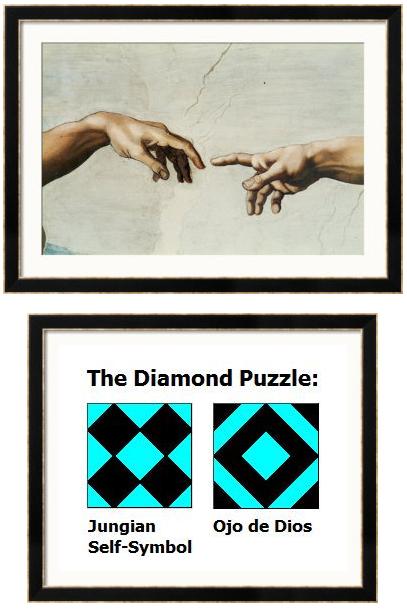
Related material:
“A great deal has been made of the fact that
Forbidden Planet is essentially William Shakespeare’s
The Tempest (1611) in an science-fiction setting. It is this that transforms
Forbidden Planet into far more than a mere pulp science-fiction story” —
Richard Scheib
Dialogue from Forbidden Planet —
“… Which makes it a gilt-edged priority that one of us gets into that Krell lab and takes that brain boost.”
Dialogue from another story —
“They thought they were doing a linear magnification, sort of putting me through a magnifying glass.”
“Sizewise?”
“Brainwise, but what they did was multiply me by myself into a quadratic.”
— Psychoshop, by Bester and Zelazny, 1998 paperback, p. 7
“… which would produce a special being– by means of that ‘cloned quadratic crap.’ [P. 75] The proper term sounds something like ‘Kaleideion‘….”
“So Adam is a Kaleideion?”
She shook her head.
“Not a Kaleideion. The Kaleideion….”
— Psychoshop, 1998 paperback, p. 85
Comments Off on Wednesday July 29, 2009
Tuesday, July 28, 2009
Comments Off on Tuesday July 28, 2009
Monumental
Anniversary

The Associated Press this morning —
“Today’s Highlight in History:
On July 28, 1609, the English ship Sea Venture, commanded by Admiral Sir George Somers, ran ashore on Bermuda after nearly foundering at sea during a storm.”
“… the Sea Venture story is two tales in one. There’s the hurricane at sea, and then there is the Bermuda wreck becoming an inspiration for ‘The Tempest.’ The first is one of the most dramatic adventures of the era, and the second is a fascinating detective story.”
Robert Sean Brazil, scholar —
“It has been a commonplace in English literary criticism that Shakespeare’s play, ‘The Tempest,’ was modeled on these accounts…. However, this common wisdom is almost certainly a falsity. A monumental error.”
Related material:
Plot summary by “Anonymous” at imdb.com of a feminist film version of “The Tempest” (now in post-production):
“In Julie Taymor’s version of ‘The Tempest,’ the gender of Prospero has been switched to Prospera. Going back to the 16th or 17th century, women practicing the magical arts of alchemy were often convicted of witchcraft.”
Taymor’s “Tempest” stars, as Prospera, the famed portrayer of monarchs Helen Mirren. Another work dealing with alchemy suitable for Mirren (who is also known as Detective Inspector Jane Tennison):
The Eight, by Katherine Neville, is perhaps
the greatest bad novel of the twentieth century. If it were made into a movie, who should be cast as the Black Queen? (“…the dignified silver-haired woman danced sinuously…” — p. 241)

Comments Off on Tuesday July 28, 2009
Monday, July 27, 2009
Field Dance
The New York Times
on June 17, 2007:
Design Meets Dance,
and Rules Are Broken
Yesterday's evening entry was
on the fictional sins of a fictional
mathematician and also (via a link
to St. Augustine's Day, 2006), on
the geometry of the I Ching* —
The eternal
combined with
the temporal:

The fictional mathematician's
name, noted here (with the Augustine-
I Ching link as a gloss) in yesterday's
evening entry, was Summerfield.
From the above Times article–
"Summerspace," a work by
choreographer Merce Cunningham
and artist Robert Rauschenberg
that offers a competing
vision of summer:

Cunningham died last night.

From left, composer John Cage,
choreographer Merce Cunningham,
and artist Robert Rauschenberg
in the 1960's
"When shall we three meet again?"
* Update of ca. 5:30 PM 7/27– today's online
New York Times (with added links)– "The
I Ching is the 'Book of Changes,' and Mr. Cunningham's choreography became an expression of the nature of
change itself. He presented successive images without
narrative sequence or
psychological causation, and the audience was allowed to watch dance as one might watch successive events in a landscape or on a street corner."
Comments Off on Monday July 27, 2009
Sunday, July 26, 2009
Happy Birthday,
Inspector Tennison

(See entries of
November 13, 2006)

Related material
for Prospera:
Comments Off on Sunday July 26, 2009
"Much Bing,
High Bing"
— Wallace Stevens,
quoted here on the
date of Dash Snow's death

Above collage:
Awake and Shing
"What a swell party
this is."
— Cole Porter
Comments Off on Sunday July 26, 2009
Saturday, July 25, 2009
Icon

“Unsheathe your dagger definitions.“
— James Joyce, Ulysses
The entry of 12:06 PM Thursday, July 23, contained a link to the journal Red Kite Prayer. The “red kite” is the red flag posted near the end of the Tour de France.
Thanks for a definition are due to the journal Flahute. A quotation from that journal:
“There’s only one shot that’s in harmony with the field. The home of your authentic swing. That flag… and all that you are.”
— The Legend of Bagger Vance
See also yesterday’s Log24 post.
Comments Off on Saturday July 25, 2009
Friday, July 24, 2009
Comments Off on Friday July 24, 2009
Thursday, July 23, 2009
On Chris Hipp, who died of an apparent heart attack at 47 on July 14 (Bastille Day), 2009:
“‘He was the father of blade technology when he was with RLX,’ Jim Hall, president of the Blade System Alliance, said in an interview. ‘He invented the blade server.'”
“Hall said Hipp was a natural inventor who wanted to be on the cutting edge.”
— Jeffrey Burt at eWeek.com
Epitaph by a friend:
“He was known as a determined, fearsome and fair competitor.”
— Red Kite Prayer
Hipp’s motto was “pounding idiots.”*
From a website celebrating the life and family (cf. previous two entries) of Leonard Shlain, author of Art & Physics and pioneering surgeon:
“Shlain n: unique last name of Russian origins. Possible meanings: 1: Sound sword makes as it’s pulled from sheath” —Shlain.com
A more authentic sound:
“The blade actually does sing. When it is withdrawn from the sheath it makes a ‘Tshuiiing’ sound as one hears in the movies. It rings like a bell.”

Steel Addiction, Custom Knives
A less authentic sound:

* The residents of Id (as in the above cartoon) are known, affectionately, as Idiots.
Comments Off on Thursday July 23, 2009
A Tangled Tale
Proposed task for a quantum computer:
"Using Twistor Theory to determine the plotline of Bob Dylan's 'Tangled up in Blue'"
One approach to a solution:
"In this scheme the structure of spacetime is intrinsically quantum mechanical…. We shall demonstrate that the breaking of symmetry in a QST [quantum space-time] is intimately linked to the notion of quantum entanglement."
— "Theory of Quantum Space-Time," by Dorje C. Brody and Lane P. Hughston, Royal Society of London Proceedings Series A, Vol. 461, Issue 2061, August 2005, pp. 2679-2699
(See also The Klein Correspondence, Penrose Space-Time, and a Finite Model.)
For some less technical examples of broken symmetries, see yesterday's entry, "Alphabet vs. Goddess."
That entry displays a painting in 16 parts by Kimberly Brooks (daughter of Leonard Shlain– author of The Alphabet Versus the Goddess— and wife of comedian Albert Brooks (real name: Albert Einstein)). Kimberly Brooks is shown below with another of her paintings, titled "Blue."

Click image to enlarge.
"She was workin' in a topless place
And I stopped in for a beer,
I just kept lookin' at the side of her face
In the spotlight so clear.
And later on as the crowd thinned out
I's just about to do the same,
She was standing there in back of my chair
Said to me, 'Don't I know your name?'
I muttered somethin' underneath my breath,
She studied the lines on my face.
I must admit I felt a little uneasy
When she bent down to tie the laces of my shoe,
Tangled up in blue."
-- Bob Dylan
Further entanglement with blue:
The website of the Los Angeles Police Department, designed by Kimberly Brooks's firm, Lightray Productions.
Further entanglement with shoelaces:
"Entanglement can be transmitted through chains of cause and effect– and if you speak, and another hears, that too is cause and effect. When you say 'My shoelaces are untied' over a cellphone, you're sharing your entanglement with your shoelaces with a friend."
— "What is Evidence?," by Eliezer Yudkowsky
Comments Off on Thursday July 23, 2009
Wednesday, July 22, 2009
Alphabet vs. Goddess
Continued…

… from June 11, 2008.
"Just as both tragedy and comedy can be written by using the same letters of the alphabet, the vast variety of events in this world can be realized by the same atoms through their different arrangements and movements. Geometry and kinematics, which were made possible by the void, proved to be still more important in some way than pure being."
Werner, Kimberly;
Kimberly, Werner.

Happy Feast of
St. Mary Magdalene.
Comments Off on Wednesday July 22, 2009
Tuesday, July 21, 2009
Today's Readings:
-
The White Itself
Plato and the "concrete universal"--
Log24 on Thursday, July 16, 2009
-
Edged with Brown
Context for a Log24 entry of July 16:
"So we moved, and they, in a formal pattern,
Along the empty alley, into the box circle,
To look down into the drained pool.
Dry the pool, dry concrete, brown edged,
And the pool was filled with water out of sunlight,
And the lotos rose, quietly, quietly,
The surface glittered out of heart of light...."
-
Signifying Nothing
An essay on Harvard professor
Henry Louis Gates, Jr.
-
Professor Gates Arrested
A racial incident in Cambridge
on Thursday, July 16, 2009
-
New England White
Race relations in Academia
-
Notes on Mathematics
and Narrative
"... the glue that binds the brotherhood
is ultimately made not of
love and interracial harmony,
but of something stronger and more
enduring: shame, fear, and greed."
-- Review of New England White
-
Don't Forget Hate
Cf. Eugene Burdick and The Word, 1966.
More recently, Tom Wolfe and The Word
and Pig and Rat Get Lost.
Comments Off on Tuesday July 21, 2009
Monday, July 20, 2009
The First Post
in this weblog:
The Diamond Theorem
Related material:
From Sunday’s New York Times, Tom Wolfe on the moon landing forty years ago:
What NASA needs now is the power of the Word. On Darwin’s tongue, the Word created a revolutionary and now well-nigh universal conception of the nature of human beings, or, rather, human beasts. On Freud’s tongue, the Word means that at this very moment there are probably several million orgasms occurring that would not have occurred had Freud never lived. Even the fact that he is proved to be a quack has not diminished the power of his Word.
July 20, 1969, was the moment NASA needed, more than anything else in this world, the Word. But that was something NASA’s engineers had no specifications for. At this moment, that remains the only solution to recovering NASA’s true destiny, which is, of course, to build that bridge to the stars.
Tom Wolfe is the author of “The Right Stuff,” an account of the Mercury Seven astronauts.
Commentary
The Word according to St. John:

Comments Off on Monday July 20, 2009
Sunday, July 19, 2009
Blaise Pascal:
"L’unité jointe à l’infini ne l’augmente de rien, non plus qu’un pied à une mesure infinie. Le fini s’anéantit en présence de l’infini, et devient un pur néant….
Nous connaissons qu’il y a un infini, et ignorons sa nature. Comme nous savons qu’il est faux que les nombres soient finis, donc il est vrai qu’il y a un infini en nombre. Mais nous ne savons ce qu’il est: il est faux qu’il soit pair, il est faux qu’il soit impair; car, en ajoutant 1 unité, il ne change point de nature; cependant c’est un nombre, et tout nombre est pair ou impair (il est vrai que cela s’entend de tout nombre fini). Ainsi…."
"Unity joined to infinity adds nothing to it, no more than one foot to an infinite measure. The finite is annihilated in the presence of the infinite, and becomes a pure nothing….
We know that there is an infinite, and are ignorant of its nature. As we know it to be false that numbers are finite, it is therefore true that there is an infinity in number. But we do not know what it is. It is false that it is even, it is false that it is odd; for the addition of a unit can make no change in its nature. Yet it is a number, and every number is odd or even (this is certainly true of every finite number). So…."
— Pensées (trans. W. F. Trotter), Courier Dover Publications, 2003
"
Le fini s’anéantit
en présence de l’infini,
et devient un pur néant…."
Un Pur Néant:
"So did God cause the big bang?
Overcome by metaphysical lassitude,
I finally reach over to my bookshelf
for The Devil's Bible.
Turning to Genesis I read:
'In the beginning
there was nothing.
And God said,
'Let there be light!'
And there was still nothing,
but now you could see it.'"
— Jim Holt, Big-Bang Theology,
Slate's "High Concept" department
Illustration:
Ainsi….
"In the garden of Adding,
Live Even and Odd"
— E. L. Doctorow
Illustration:

4 + 5 = 9.
Comments Off on Sunday July 19, 2009
Saturday, July 18, 2009
Comments Off on Saturday July 18, 2009
Thursday, July 16, 2009
Comments Off on Thursday July 16, 2009
The White Itself
David Ellerman has written that
"The notion of a concrete universal occurred in Plato's Theory of Forms [Malcolm 1991]."
A check shows that Malcolm indeed discussed this notion ("the Form as an Ideal Individual"), but not under the name "concrete universal."
See Plato on the Self-Predication of Forms, by John Malcolm, Oxford U. Press, 1991.
From the publisher's summary:
"Malcolm…. shows that the middle dialogues do indeed take Forms to be both universals and paradigms…. He shows that Plato's concern to explain how the truths of mathematics can indeed be true played an important role in his postulation of the Form as an Ideal Individual."
Ellerman also cites another discussion of Plato published by Oxford:
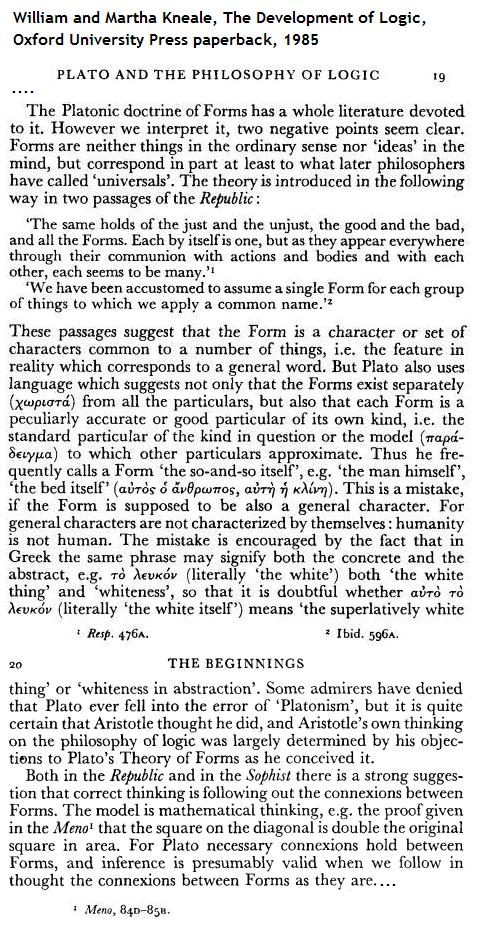
For a literary context, see W. K. Wimsatt, Jr., "The Structure of the Concrete Universal," Ch. 6 in Literary Theory: An Anthology, edited by Julie Rivkin and Michael Ryan, Wiley-Blackwell, 2004.
Other uses of the phrase "concrete universal"– Hegelian and/or theological– seem rather distant from the concerns of Plato and Wimsatt, and are best left to debates between Marxists and Catholics. (My own sympathies are with the Catholics.)
Two views of "the white itself" —
"So did God cause the big bang?
Overcome by metaphysical lassitude,
I finally reach over to my bookshelf
for The Devil's Bible.
Turning to Genesis I read:
'In the beginning
there was nothing.
And God said,
'Let there be light!'
And there was still nothing,
but now you could see it.'"
-- Jim Holt, Big-Bang Theology,
Slate's "High Concept" department

"The world was warm and white when I was born:
Beyond the windowpane the world was white,
A glaring whiteness in a leaded frame,
Yet warm as in the hearth and heart of light."
-- Delmore Schwartz
Comments Off on Thursday July 16, 2009
Wednesday, July 15, 2009
Comments Off on Wednesday July 15, 2009
DETAIL
of obituaries page,
New York Times,
Monday morning:

Detail of arts page,
New York Times, Wednesday morning:
(Click ad for more on the Monday night death of Dash Snow.)
 |

Hurt yet?
_________________
Update of 5:01 AM:
Lavery Hits
Literary Jackpot
From the top right of
this morning's online
New York Times front page:

Click on voodoo doll
for further details.
See also…
1. Monday's link to a
Wallace Stevens poem,
"Snow and Stars"
2. The conclusion of this
morning's Times obituary
for artist Dash Snow, which
gives his daughter's name…
"Secret."
3. David Lavery's excellent
analysis of the classic
Conrad Aiken story
"Silent Snow, Secret Snow."
Comments Off on Wednesday July 15, 2009
Tuesday, July 14, 2009
Herschel’s Onion
The Herschel Chronicle, by Constance A. Lubbock, Cambridge University Press, 1933, page 139:
“Sir John Herschel has recorded that his father [astronomer William Herschel, 1738-1822], when observing at Datchet, ‘when the waters were out round his garden, used to rub himself all over, face and hands &c., with a raw onion, to keep off the infection of the ague, which was then prevalent; however he caught it at last.'”
Herschel and his onion appear in a large illustration on the cover of next Sunday’s New York Times Book Review. A review, titled “Science and the Sublime,” states that Herschel and his sister
“spent endless hours at the enormous telescopes that Herschel constructed, rubbing raw onions to warm their hands….'”
Clearly the anti-ague motive makes more sense.
A quotation from the book under review, The Age of Wonder: How the Romantic Generation Discovered the Beauty and Terror of Science (published today, Bastille Day, 2009):
“The emphasis of on [sic] secular, humanist (even atheist) body of knowledge… was particularly strong in revolutionary France.”
This, apparently, is the terror part.
A related quotation from Publishers Weekly:
“It’s an engrossing portrait of scientists as passionate adventurers, boldly laying claim to the intellectual leadership of society. Illus. (July 14)”
On its front page next Sunday, The New York Times Book Review boldly lays claim to intellectual leadership with the following opening sentence:
“In this big two-hearted river of a book, the twin energies of scientific curiosity and poetic invention pulsate on every page.”
The sentence begins with an insult to Hemingway and ends with a cascade of vulgarized-science bullshit. Its author, Christopher Benfey, has done better, and should be ashamed.
Comments Off on Tuesday July 14, 2009
For Galois on Bastille Day Elements
of Finite Geometry
Some fans of the alchemy in
Katherine Neville’s novel
The Eight and in Dan Brown’s
novel Angels & Demons may
enjoy the following analogy–

Note that the alchemical structure
at left, suited more to narrative
than to mathematics, nevertheless
is mirrored within the pure
mathematics at right.
Related material
on Galois and geometry:
Geometries of the group PSL(2, 11)
by Francis Buekenhout, Philippe Cara, and Koen Vanmeerbeek. Geom. Dedicata, 83 (1-3): 169–206, 2000–
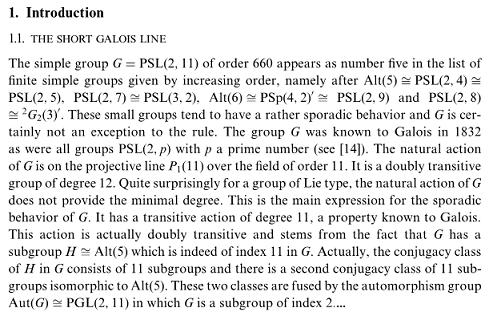
|
Comments Off on Tuesday July 14, 2009
Monday, July 13, 2009
Comments Off on Monday July 13, 2009
For those who prefer
the less tasteful:
Vega’s more recent album

and this morning’s
New York Times:
(Click to enlarge.)

Note
the story on the July 11 death of boxer Arturo Gatti in Brazil,
apparently possibly not [updates of July 18 and 30] at the hands of his wife,
a former exotic dancer.
Connoisseurs of tasteless prose will appreciate the following:
“Vega writes from a perspective of memory and maturity… applying a musical Brazilian wax to ‘Pornographer’s Dream‘….”
— Review of Suzanne Vega’s album “Beauty & Crime” by Don McLeese
Comments Off on Monday July 13, 2009
Sunday, July 12, 2009
In honor of
William York Tindall
(yesterday's entry):
A Literary Symbol
for Boyne Day
Mary Karr was "an unfashionably bookish kid whose brain wattage was sapped by a consuming inner life others didn't seem to bear the burden of. I just seemed to have more frames per second than other kids."
Comments Off on Sunday July 12, 2009
Saturday, July 11, 2009
Comments Off on Saturday July 11, 2009
Friday, July 10, 2009
Comments Off on Friday July 10, 2009
Comments Off on Friday July 10, 2009
Light History

Before the Screwing

“Very impressive, Herr Tesla,
but let’s not forget the
little man in the boat.”
Courtesy of Wired.com:
1895: Charles Proteus Steinmetz receives a patent for a “system of distribution by alternating currents.” His engineering work makes it practical to build a widespread power grid for use in lighting and machinery alike.
Comments Off on Friday July 10, 2009
In Memory of
Leonard Shlain
From Shlain’s website,
some news I had not
heard before: Shlain
died on May 11, 2009.
Also from that site:
“A celebration of Leonard’s
life will be held on Friday,
May 15th, at 1:00 PM at
Sherith Israel Synagogue…
San Francisco….”
In his memory, here is
a link from this journal
on the date, May 15,
of his memorial:
Log24, Jan. 1-15, 2006.
See also the tribute film
“A Good Life,” by
Tiffany Shlain.
Comments Off on Friday July 10, 2009
Thursday, July 9, 2009
Comments Off on Thursday July 9, 2009
An Aleph for Pynchon
Part I:
A California Sixties version
of Heaven’s Gate:
Aleph Sanctuary, by Mati Klarwein
Part II:
Log24 entries of April 29, 2009
(esp. the link to Anastasia Ashley)
Part III:
Inherent Vice,
a novel by Thomas Pynchon
to be published in August 2009
“The serpent’s eyes shine
As he wraps around the vine…”
—
Don Henley
Comments Off on Thursday July 9, 2009
Wednesday, July 8, 2009
Comments Off on Wednesday July 8, 2009
Tuesday, July 7, 2009
| From Log24 on Nov. 12, 2005:
“‘Tikkun Olam, the fixing of the world,’ she whispers. ‘I’ve been gathering up the broken vessels to make things whole again.'”
“ Tikkun Olam, the gathering of the divine fragments, is a religious activity…. How do we work for the repair of the world? If we live in a humpty dumpty world, how do we get it all put back together again?”
— A Sunday Sermon
for Yom Kippur
by the Rev. Joshua Snyder
on Oct. 5, 2003
[See also Log24 on that date.]
“… the tikkun can’t start until everyone asks what happened– not just the Jews but everybody. The strange thing is that Christ evidently saw this.”
— Martha Cooley, The Archivist
|
Comments Off on Tuesday July 7, 2009
Monday, July 6, 2009
Comments Off on Monday July 6, 2009
Art and Faith
Virginia Woolf, The Waves, Harvest Books paperback, 1950, pp. 248-249:
"On the outskirts of every agony sits some observant fellow who points; who whispers as he whispered to me that summer morning in the house where the corn comes up to the window, 'The willow grows on the turf by the river. The gardeners sweep with great brooms and the lady sits writing.' Thus he directed me to that which is beyond and outside our own predicament; to that which is symbolic, and thus perhaps permanent, if there is any permanence in our sleeping, eating, breathing, so animal, so spiritual and tumultuous lives."
Up to the first semicolon, this is the Associated Press thought for today.
Related aesthetic philosophy from The Washington Post:
"Varnedoe's lectures were ultimately about faith, about his faith in the power of abstraction, and abstraction as a kind of anti-religious faith in itself, a church of American pragmatism that deals with the material stuff of experience in the history of art. To understand these lectures, which began promising an argument about how abstraction works and ended with an almost medieval allegory of how man confronts the void, one has to understand that Varnedoe views the history of abstraction as a pastor surveys the flock."
Comments Off on Monday July 6, 2009
Sunday, July 5, 2009
Comments Off on Sunday July 5, 2009
Saturday, July 4, 2009
Comments Off on Saturday July 4, 2009
Friday, July 3, 2009
Damnation Morning
continued
“The tigers of wrath are wiser
than the horses of instruction.”
— Blake
“… the moment is not
properly an atom of time
but an atom of eternity.
It is the first reflection
of eternity in time, its first
attempt, as it were, at
stopping time….”
— Kierkegaard
Todo lo sé por el lucero puro
que brilla en la diadema de la Muerte.
— Rubén Darío
Related material:
The deaths of
Ernest Hemingway
on the morning of
Sunday, July 2, 1961,
and of Alexis Arguello
on the morning of
Wednesday, July 1, 2009.
See also philosophy professor
Clancy Martin in the
London Review of Books
(issue dated July 9, 2009)
on AA members as losers—
“the ‘last men,’ the nihilists,
the hopeless ones.”
Comments Off on Friday July 3, 2009
Thursday, July 2, 2009
Meditation
on a joke by George Carlin,
a passage by Kierkegaard,
and the death on this date
12 years ago
of actor James Stewart
The Catholic
Carlin:
“Thank you, Mr. Twain. Have your people call my people.” –George Carlin on learning he had won the Mark Twain award. Twain’s people were Protestant, Carlin’s Catholic.
The Protestant Kierkegaard:
“… the moment is not properly an atom of time but an atom of eternity. It is the first reflection of eternity in time, its first attempt, as it were, at stopping time….
Once here in Copenhagen there were two actors who probably never thought that their performance could have a deeper significance. They stepped forth onto the stage, placed themselves opposite each other, and then began the mimical representation of one or another passionate conflict. When the mimical act was in full swing and the spectators’ eyes followed the story with expectation of what was to follow, they suddenly stopped and remained motionless as though petrified in the mimical expression of the moment. The effect of this can he exceedingly comical, for the moment in an accidental way becomes commensurable with the eternal.”
Catholic tableau
(with Vivien Leigh
representing the Church)
of Salvation by Works —

Protestant tableau
(with James Stewart
as Protestant Pilgrim)
of Salvation by Grace —

Click on either tableau
for a (much) larger image.
* Thanks to University Diaries for
an entry on
Clancy Martin, a philosophy professor in the “show me” state, and his experiences with AA. For a sample of Martin’s style, see
a piece he wrote on Fabergé Easter eggs. For other Easter egg material, see this journal and (via a link)
The Harvard Crimson,
Easter 2008. A valuable philosophical remark by Martin in a
recent interview:
“An unscrupulous jeweler will swap diamonds for cheaper ones when jewelry is dropped off to be sized or repaired, he said.
‘It happens all the time,’ Martin said. ‘Nobody’s watching.'”
Comments Off on Thursday July 2, 2009
Hieron Grammaton, Part III*
The Old Man and the Light
In memory of
Ernest Hemingway,
who died on this date
in 1961, a story
in three parts:
I — Eye of Raven

Fermata
II — Psyche and Symbol

Leonard Baskin, detail of
cover for Jung’s
Psyche and Symbol
III — Raven Steals the Light
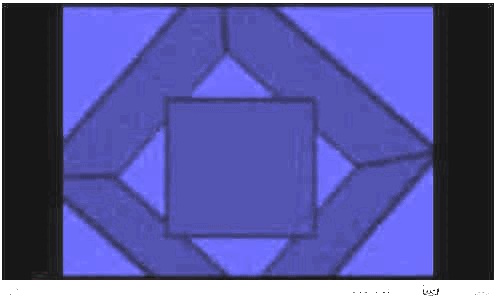
Detail from the story
“Raven Steals the Light”
Midrash:
“To the earnestness of death belongs precisely that capacity for awakening, that resonance of a profound mockery which, detached from the thought of the eternal, is an empty and often brash jest, but together with the thought of the eternal is just what it should be….” —Kierkegaard
* For Hieron Grammaton, Parts I and II, see the five Log24 entries from 6:29 PM Tuesday, June 23, to 1:00 AM Sunday, June 28.
Comments Off on Thursday July 2, 2009
Wednesday, July 1, 2009
Diamond Life
“Diamond life, lover boy. We move in space with minimum waste and maximum joy. City lights and business nights When you require streetcar desire for higher heights. No place for beginners or sensitive hearts When sentiment is left to chance. No place to be ending but somewhere to start.”
|
Comments Off on Wednesday July 1, 2009
Comments Off on Wednesday July 1, 2009
Comments Off on Wednesday July 1, 2009










